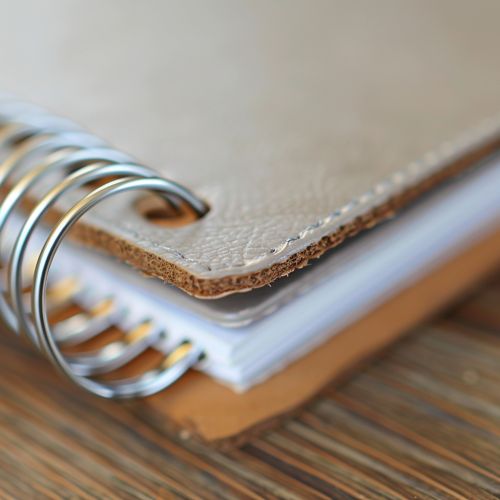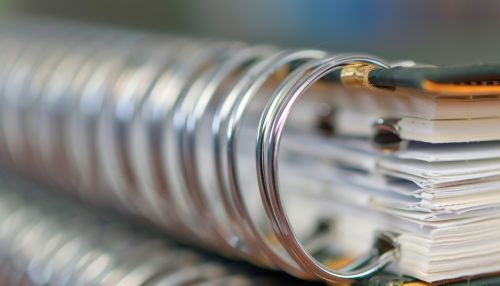Spiral Binding: Difference between revisions
(Created page with "== Introduction == Spiral binding, also known as coil binding, is a method of securing the pages of a book or document together using a durable plastic or metal coil that is threaded through a series of evenly spaced holes along the edge of the pages. This binding technique is widely used for notebooks, manuals, reports, and other documents that require a robust and flexible binding solution. == History == The origins of spiral binding can be traced back to the early 2...") |
No edit summary |
||
| Line 17: | Line 17: | ||
3. **Crimping the Ends**: The ends of the coil are crimped to prevent it from unraveling. This step is crucial for ensuring the durability and longevity of the binding. | 3. **Crimping the Ends**: The ends of the coil are crimped to prevent it from unraveling. This step is crucial for ensuring the durability and longevity of the binding. | ||
[[Image:Detail-93213.jpg|thumb|center|Close-up of a spiral-bound notebook with a focus on the binding coil.|class=only_on_mobile]] | |||
[[Image:Detail-93214.jpg|thumb|center|Close-up of a spiral-bound notebook with a focus on the binding coil.|class=only_on_desktop]] | |||
== Advantages == | == Advantages == | ||
Latest revision as of 03:18, 22 June 2024
Introduction
Spiral binding, also known as coil binding, is a method of securing the pages of a book or document together using a durable plastic or metal coil that is threaded through a series of evenly spaced holes along the edge of the pages. This binding technique is widely used for notebooks, manuals, reports, and other documents that require a robust and flexible binding solution.
History
The origins of spiral binding can be traced back to the early 20th century. The method gained popularity due to its simplicity and the ease with which it allows documents to lie flat when open. The development of spiral binding was driven by the need for a more flexible and durable binding method compared to traditional bookbinding techniques.
Materials
Spiral binding materials can vary, but the most common are plastic and metal. Plastic coils are typically made from durable PVC, which offers flexibility and resistance to damage. Metal coils are usually made from wire, which provides a more rigid and professional appearance. Each material has its own advantages and is chosen based on the specific needs of the document being bound.
Process
The process of spiral binding involves several steps:
1. **Punching Holes**: The pages of the document are punched with a series of evenly spaced holes along the edge where the binding will be applied. The holes are typically round, but can also be oval or rectangular depending on the binding machine used.
2. **Inserting the Coil**: A plastic or metal coil is threaded through the holes. This can be done manually or with the aid of a machine. The coil is twisted through the holes, securing the pages together.
3. **Crimping the Ends**: The ends of the coil are crimped to prevent it from unraveling. This step is crucial for ensuring the durability and longevity of the binding.


Advantages
Spiral binding offers several advantages over other binding methods:
- **Flexibility**: The bound document can lie flat and even fold back on itself, making it easier to read and write in. - **Durability**: The binding is resistant to damage and can withstand frequent use. - **Customization**: Coils come in various colors and sizes, allowing for customization to match the document's design.
Disadvantages
Despite its many benefits, spiral binding also has some drawbacks:
- **Limited Capacity**: Spiral binding is not suitable for very thick documents, as the coils can only accommodate a certain number of pages. - **Cost**: The materials and machinery required for spiral binding can be more expensive than other binding methods.
Applications
Spiral binding is used in a variety of applications, including:
- **Notebooks**: Commonly used for school and office notebooks due to its durability and flexibility. - **Manuals**: Ideal for user manuals and technical documents that need to lie flat for easy reference. - **Reports**: Often used for business reports and presentations to give a professional appearance.
Comparison with Other Binding Methods
Spiral binding is often compared to other binding methods such as perfect binding, saddle stitching, and comb binding. Each method has its own set of advantages and is chosen based on the specific requirements of the document.
- **Perfect Binding**: Uses adhesive to bind the pages together. It offers a professional look but lacks the flexibility of spiral binding. - **Saddle Stitching**: Involves stapling the pages together along the fold. It is cost-effective but not suitable for thick documents. - **Comb Binding**: Uses a plastic comb to hold the pages together. It is similar to spiral binding but less durable.
Environmental Impact
The environmental impact of spiral binding depends on the materials used. Plastic coils are not biodegradable and contribute to plastic waste, whereas metal coils can be recycled. Efforts are being made to develop more sustainable materials for spiral binding to reduce its environmental footprint.
Innovations and Future Trends
Recent innovations in spiral binding include the development of eco-friendly materials and automated binding machines that increase efficiency. The future of spiral binding looks promising with advancements in technology and a growing emphasis on sustainability.
